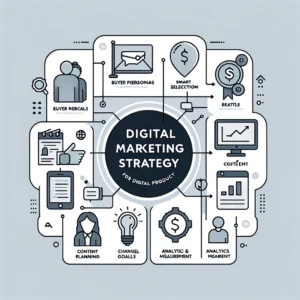The realm of digital and software product development stands as a beacon of innovation and progress. As we delve deeper into the digital age, the importance of mastering the art of product development in the software and digital sphere has become paramount. This article is crafted for experts who are well-versed in the nuances of software and digital product development, offering a deep dive into advanced strategies that drive successful outcomes.
The landscape of digital product development is marked by constant change, driven by rapid technological advancements and shifting user expectations. In this dynamic environment, developing a product is no longer just about coding and deployment; it’s about understanding the intricate web of design, user experience, market demands, and the technological capabilities that bind them together. This article aims to shed light on these multifaceted aspects, providing insights into effective strategies and best practices that lead to the creation of exceptional digital and software products.
From the initial conception of a product idea to its launch and continuous improvement, every stage of the product development process is crucial. We will explore the roles and responsibilities of the development team, the stages of product development, and the strategic considerations that must be taken into account. Additionally, we will discuss common pitfalls and how to avoid them, ensuring a comprehensive understanding of what it takes to succeed in this competitive arena.
As we journey through this article, keep in mind that digital product development is not just a process but an art form, requiring a blend of creativity, technical prowess, and strategic thinking. So, let’s embark on this journey to unravel the complexities and uncover the advanced strategies that define successful digital and software product development in today’s world.
Understanding Digital Product Development

Defining Digital Products
In the realm of technology, the term ‘digital product’ encompasses a wide array of software programs and applications, each serving a distinct function or service. These products are integral to our daily digital interactions, ranging from familiar utilities like banking and messaging apps to creative tools such as image editing software and word processors. A digital product, in its broadest sense, includes any object that interacts with digital processes, extending even to devices like smartphones and televisions. However, our focus here is on the software aspect of digital products, which involves a complex development process starting from project establishment and moving through stages like research, design, coding, testing, deployment, and release cycling.
Product vs. Feature Development
A critical distinction in the field of digital product development lies between creating entirely new products and refining or adding features to existing ones. While the development of new features, such as enhancing image upload experiences in apps or adding calculation abilities in word processors, is often still categorized under product development, it requires a slightly different approach. The development process for both new products and new features generally follows similar pathways, highlighting the adaptive nature of digital product development strategies.
The digital product development landscape is multifaceted, requiring a blend of technical expertise, creative vision, and strategic planning. Each stage of development demands a unique set of skills and approaches, making it crucial for teams to be versatile and adaptive. As we delve deeper into the roles involved and the stages of digital product development, it becomes evident that successful product creation is a result of meticulous planning, collaborative efforts, and continuous refinement.
In the next section, we will explore the diverse roles and responsibilities within a digital product development team, shedding light on how each member contributes to the successful creation of digital products.
The Digital Product Development Team
Key Roles and Responsibilities
The success of digital product development hinges on the collaborative efforts of a diverse team, each member bringing unique expertise and perspective to the table. The core team responsible for delivering outcomes typically includes the following roles:
- Product Manager: This role is pivotal in ensuring the smooth running of the project. Responsibilities include reaching business goals, planning, briefing, and coordination. The Product Manager acts as a bridge between various team members and aligns the project with the organization’s objectives.
- Product Designer (or UX Designer): Charged with creating visual artifacts, the Product Designer focuses on user experience diagrams, wireframes, high-fidelity designs, prototypes, and associated documentation. Their work is crucial in shaping how users interact with the final product.
- Engineer (Developer or Programmer): Engineers are responsible for writing, testing, and deploying the product’s code. They transform conceptual designs into functional digital solutions, playing a critical role in bringing the product to life.
Complementing these roles are additional specialists who enhance the development process:
- UX Researcher: Provides insights into user feedback and data, influencing design decisions.
- UX Writer: Crafts the textual content for the product, from button labels to instructional copy.
- Information Architect: Ensures that the user journey is logical and supports user goals.
- Product Owner: Manages the product backlog and liaises with users and the product team.
- QA Tester: Validates that the product meets design specifications and user requirements.
- Product Marketer: Drives product adoption and feature utilization through strategic marketing.
In larger organizations, senior roles like Chief Product Officer and Creative Director may oversee the broader product strategy, although their involvement in day-to-day product development might be limited. The collective expertise of this team is essential in navigating the complexities of digital product development.
This comprehensive team structure reflects the multidisciplinary nature of digital product development, where a synergy of skills and perspectives is key to creating innovative, user-centered digital products. As we move forward, we’ll delve into the stages of digital product development, examining each phase’s unique challenges and strategies.
Stages of Digital Product Development

Preliminary Phase: Laying the Groundwork
Business Plan (or Organizational Goals)
The journey of digital product development often begins with a business plan or a clear set of organizational goals. This foundational step involves outlining the product concept, market strategy, team structure, financial planning, and overarching goals. A well-defined business plan not only guides the product’s formation and evolution but also influences its life cycle in relation to the company’s financial landscape. In many cases, the product direction may not be explicitly detailed in the business plan, yet it forms the basis for critical decision-making and kick-starts the development process.
Shaping
Shaping, the initial ‘pre-step’ in product development, involves decision-makers conceptualizing what the product should be and its features. This phase includes rough design layouts, flow charts, feature spreadsheets, and other preliminary documentation. Shaping sets the direction of the project, addressing technical questions and eliminating major unknowns to ensure the team is not set up for failure due to significant uncertainties from the onset.
Digital Product Strategy
Creating a digital product strategy is a crucial pre-step that flows from the business plan or shaping phase. It outlines the necessary steps, team composition, budget, nature of releases, milestones, and goals for the product’s development and launch. A well-crafted strategy serves as a roadmap, guiding the team through the complex journey of bringing the digital product to fruition.
1. Discovery and Brief Formation
The discovery phase is where the product team reviews the shaping and strategy, questioning assumptions and confirming the project’s direction. Key activities include understanding the problem to be addressed, developing a general solution approach, and creating a project brief. This stage may involve user testing, competitor analysis, and trend analysis to refine the understanding and approach.
2. Design
During the design phase, designers question the brief and develop layouts using various approaches, from low-fidelity concepts to high-fidelity designs. Tools like Figma, Sketch, and Miro are commonly used. It’s crucial for designers and product managers to collaborate closely with engineers to ensure feasibility and alignment with technical capabilities.
3. Engineering
Engineering methodologies such as Waterfall, Agile, DevOps, and Lean are employed during this phase. Each methodology offers distinct advantages and focuses, from strict sequential progress to a more iterative, flexible approach. The choice of methodology often depends on the product’s nature and the team’s working style.
4. Pre-release Testing
Testing is an ongoing activity throughout the development process. As the product nears completion, it undergoes intensive scrutiny from QA testers, product managers, and designers. Alpha and Beta testing phases involve real users to ensure the product functions as intended and to gather valuable user feedback.
5. Launch and Initial Post-launch
The launch phase is critical, involving strategies like soft launches, big bang launches, staggered launches, or phased launches, each with its own set of advantages and challenges. Post-launch, the focus shifts to monitoring product performance, optimizing user experience, and coordinating with various teams like marketing, sales, and customer support to ensure a successful rollout.
In the subsequent phases of digital product development, the emphasis is on continuous improvement and responsiveness to user feedback, reflecting the dynamic nature of the digital product lifecycle. This iterative process ensures that the product remains relevant and effective in meeting user needs and expectations.
Ongoing Improvement and User Feedback
Iterative Release Cycle
The lifecycle of a digital product is characterized by a continuous cycle of improvement and adaptation. Following the launch, almost all digital products enter a phase of ongoing development, driven by feedback from users and other stakeholders. This feedback is critical in shaping the future iterations of the product. It’s transformed into actionable work units that go through the development stages and are included in new updates or versions of the product. This iterative process allows for both minor and major changes, ensuring that the product evolves to meet the changing needs and expectations of its users. It’s a cycle that can continue indefinitely, underscoring the importance of responsiveness and adaptability in digital product development.
Key Considerations and Common Mistakes in Product Development
Crucial Aspects to Remember in Development
- User-Centric Approach: The success of a digital product is heavily reliant on user satisfaction. Gaining insights from users and prioritizing their needs and preferences is crucial.
- Methodology Flexibility: It is acceptable for different functional teams within a product development project to employ varying methodologies, finding what works best for their specific tasks.
- Cross-Team Collaboration: Openness to the perspectives and expertise of individuals across all teams enhances the product development process.
- Quality over Timeliness: A product that excels in meeting user needs, even if delayed, is preferable to a product that is timely but falls short in quality.
- Business Goals Alignment: Understanding and aligning with the business goals is essential in informing the product development process and ensuring its relevance to the organization’s objectives.
5 Digital Product Development Mistakes to Avoid
- Overreliance on MVPs: Relying too heavily on Minimum Viable Products can pose risks to your brand and long-term success.
- Premature Design Finalization: Avoid setting the design too early in the process; early-stage visuals should be considered disposable.
- Ignoring Shaping Insights: The wisdom gained during the shaping phase should be revered and utilized throughout the development process.
- Neglecting Research: Even without a dedicated UX Researcher, it’s crucial to conduct essential research to understand user needs and market trends.
- Halting Testing and Improvement: Continuous testing and improvement are vital for the success and relevance of the digital product.
Digital product development is a complex and multifaceted process, involving a blend of management, design, engineering, and marketing. Each aspect is intricate in itself and requires a comprehensive approach to ensure the success of the final product. The process sits within the broader context of the entire business operation, underscoring the need for a holistic view and strategic alignment at every stage of development.
Conclusion of Product Development
The landscape of digital and software product development is dynamic and demanding, requiring a strategic, comprehensive approach to navigate its complexities successfully. As we have explored, this process extends far beyond mere coding and technical implementation. It encompasses a deep understanding of user needs, market trends, collaborative team efforts, and continuous adaptation to feedback and changing conditions.
Key takeaways from our exploration include:
- The Significance of Team Collaboration: The diverse roles within a product development team, from product managers and designers to engineers and marketers, each play a pivotal role in shaping the product. The synergy of their combined skills and perspectives is crucial for innovation and user satisfaction.
- Strategic Planning and Flexibility: From the initial shaping and strategy formation to the design and engineering phases, a strategic approach tailored to the product’s unique requirements and user expectations is vital. Flexibility in methodologies and adaptation to feedback ensures that the product remains relevant and effective.
- User-Centric Design and Development: Keeping the end-user at the forefront of every decision is paramount. Understanding their needs, preferences, and behaviors ensures that the product not only meets but exceeds their expectations.
- Continuous Improvement: The iterative release cycle, characterized by regular feedback and ongoing development, is essential in the fast-paced digital world. This approach allows for timely adjustments and enhancements, ensuring the product remains cutting-edge and user-friendly.
- Avoiding Common Pitfalls: Recognizing and avoiding common mistakes, such as premature design finalization or neglecting user research, can significantly enhance the success rate of product development projects.
In conclusion, digital and software product development is an intricate and rewarding field, offering immense opportunities for innovation and growth. By embracing a comprehensive, user-focused approach and being mindful of the common challenges, developers and teams can create products that not only succeed in the market but also drive the technological frontier forward.




